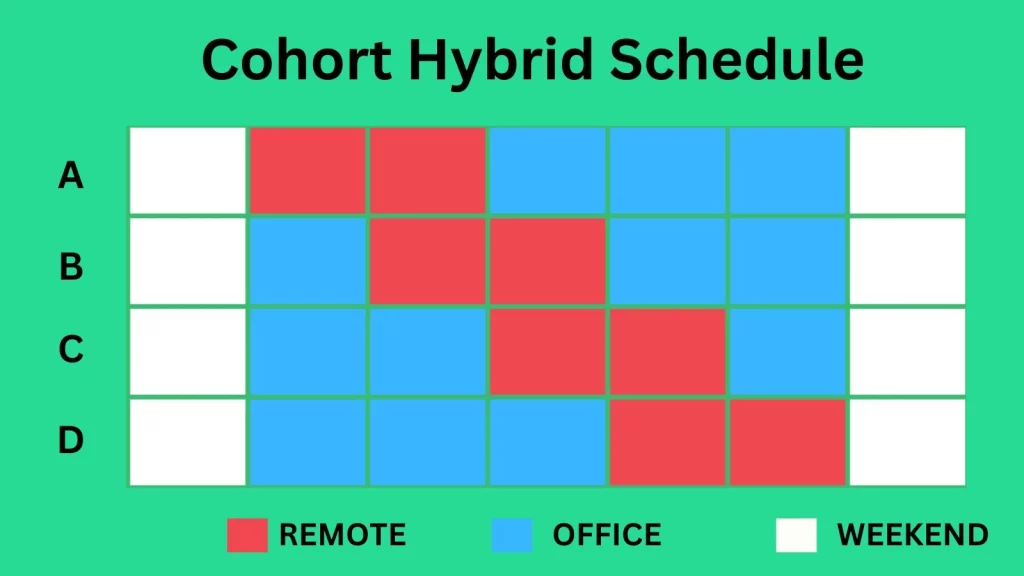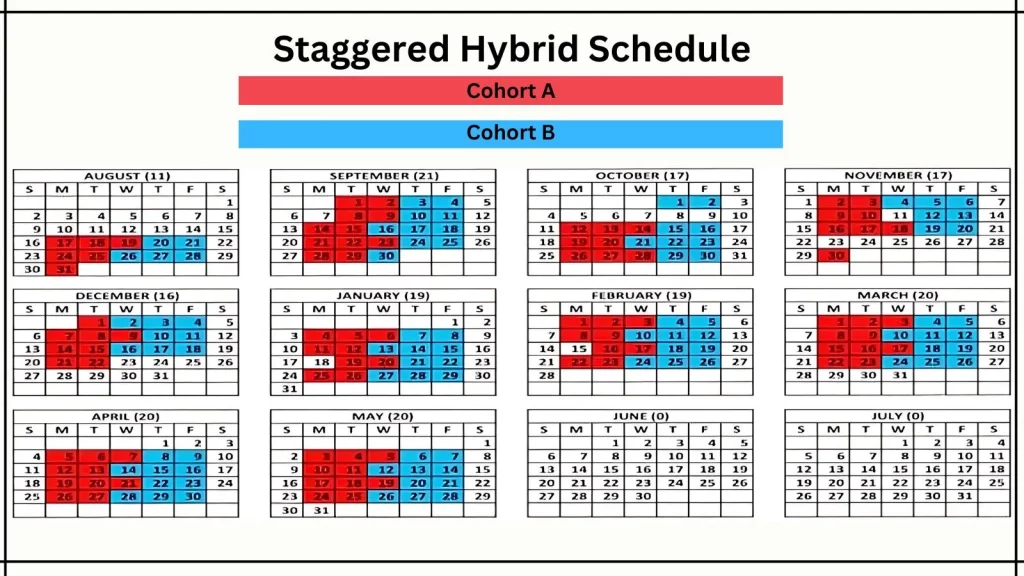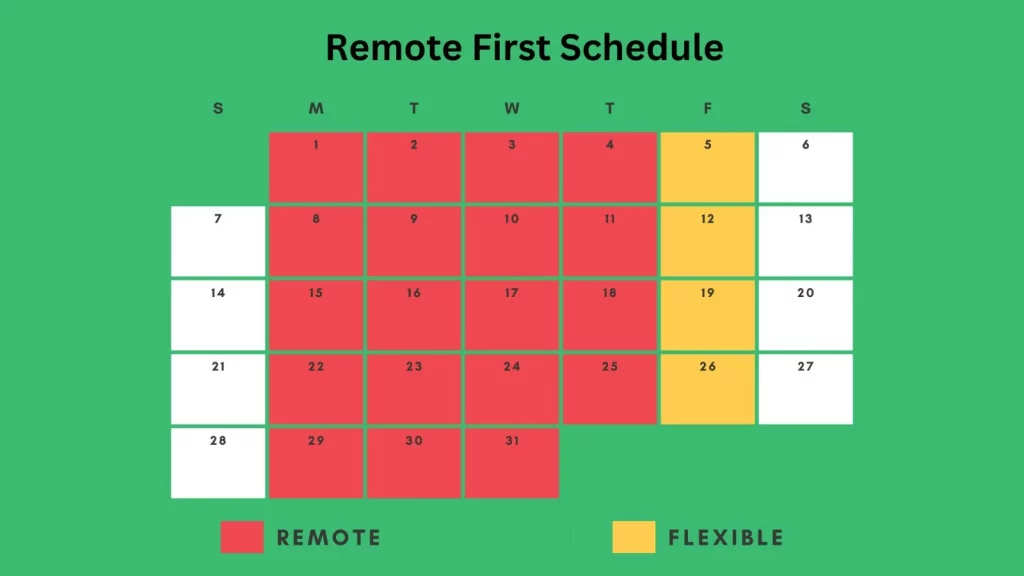Nowadays, hybrid work models are gaining popularity- as more organizations adopt hybrid work schedules. This flexible arrangement blends in-office and remote work, allowing employees to collaborate effectively while maintaining a healthy work-life balance.
Employees benefit from reduced commuting time, increased autonomy, and the ability to choose where they work best. However, it’s not just employees who gain from this model- employers also reap significant advantages.
A hybrid work schedule can reduce operational costs by minimizing the need for office space, utilities, and on-site resources. Additionally, it boosts productivity by enabling employees to work in environments where they feel most comfortable. This model also attracts top talent by offering flexibility, which has become a key factor in job satisfaction and retention.
By balancing remote and in-person work, the hybrid schedule promotes a more agile, efficient workforce, making it a win-win for both employers and employees.
Let’s learn more about the hybrid work schedule and how it works.
Listen To The Podcast Now!
What Is A Hybrid Work Schedule?
A hybrid work schedule offers employees the flexibility to split their time between working in the office and remotely. Unlike traditional office setups or full-time remote work, a hybrid work model allows employees to choose where they work based on the demands of their tasks. This schedule provides the autonomy to work from home, reducing commuting stress and enabling in-person collaboration whenever needed.
Employees are not confined to the office, nor are they fully remote workers. The hybrid schedule strikes a balance, empowering individuals to manage their work-life integration more effectively. By adapting to different work environments, employees can also achieve higher productivity, improved job satisfaction, and better overall well-being.
Adopting a hybrid work schedule can be overwhelming if you manage everything manually. Fortunately, tools like EmpMonitor make it easy to efficiently track both in-office and remote employees. All you need to do is plan your hybrid work schedule and align your team so they can work effectively from the office or home.
Do you feel like creating work schedule templates for your hybrid team is too tough? Here we’ve simplified the process by showing you various types of hybrid work schedules that right fit your organization’s needs.
Types of Hybrid Work Schedules
Cohort Schedules
A cohort schedule is a hybrid work model where the employer sets a common schedule for employees, typically managed by the team leader or manager. In this structure, managers plan, to inform employees when they will work from the office and when they can work remotely.
The schedule is aligned to ensure that team members’ office and remote days overlap, fostering seamless collaboration regardless of location. This type of schedule is particularly beneficial for smaller organizations, allowing them to optimize limited office space by staggering different departments on specific days.
Pros:
- Facilitates team collaboration by aligning schedules.
- Reduces office space needs, saving on operational costs.
- Improves planning and coordination for in-office tasks.
Cons:
- Limited flexibility for individual preferences.
- Scheduling conflicts may arise if not planned carefully.
Staggered Schedules
Staggered schedules represent a more structured form of cohort hybrid schedule, where management not only sets specific days for employees to work remotely or in-office. It also determines their exact working hours. Unlike flexible schedules, where employees can choose when to start and end their day, staggered schedules require adherence to predefined work hours, ensuring consistent availability during designated times.
You can plan this type of hybrid remote work schedule for shift-driven industries, such as healthcare, where it is critical to maintain consistent staffing levels throughout the day. For example, in a hospital setting, nurses could be assigned staggered shifts, ensuring coverage around the clock- while still allowing them the flexibility to work from home for administrative tasks like patient documentation.
Pros:
- Both employees and management have clear expectations regarding attendance and working hours.
- Employers can ensure that sufficient staff are available during critical periods.
- Reduces overcrowding in the office, particularly useful in industries operating at reduced capacity.
Cons:
- Employees have less control over their work hours, which may reduce job satisfaction for some.
- Requires close monitoring to ensure employees adhere to the schedule, potentially leading to increased management complexity.
Flexible Schedules
A Flexible Hybrid Work Schedule offers maximum freedom by allowing employees to choose when and where they work within certain guidelines. This type of schedule doesn’t follow rigid rules and comes in two main variations:
- Flexi-place: Employees can decide where they want to work on any given day- as long as they meet their required weekly hours. This model allows businesses to implement a desk reservation system, reducing the need for extensive office space and cutting operational costs.
- Flexi-time: Employees have flexibility in choosing their work hours- as long as they remain available during core hours set by the company. This variation ensures collaboration and communication while accommodating employees’ personal preferences for starting and ending their workday.
Pros:
- Employees can tailor their schedules to fit personal responsibilities, leading to better well-being.
- Employees can work during their most productive hours, improving output and focus.
- Implementing flexi-place allows companies to downsize office space, saving on overhead expenses.
Cons:
- Flexibility in work locations and hours can create difficulties in scheduling team meetings and maintaining real-time communication.
- With flexi-time, ensuring that all necessary employees are available during core hours can sometimes be challenging.
Split Shift Schedules
In this split shift schedule, you can divide an employee’s workweek between the office and home. In this arrangement, employees spend certain days working on-site and the remaining days working remotely. For example, an employee might work in the office on Mondays, Wednesdays, and Fridays, while working from home on Tuesdays and Thursdays.
This schedule offers a structured balance between in-office collaboration and remote flexibility, ensuring employees have dedicated time for face-to-face meetings while also benefiting from the convenience of remote work.
Pros:
- Employees can engage in in-person teamwork while still enjoying the flexibility of remote work on certain days.
- Provides a predictable schedule, helping employees plan their work and personal commitments efficiently.
Cons:
- Fixed office and home days may not always align with personal or work demands, reducing overall flexibility.
- Employees may still incur commuting expenses on designated office days, which may offset some remote work benefits.
Office-Centric Hybrid Work Schedule
In this work schedule, the office is the primary workplace, with occasional remote work options. Employees are expected to be in the office most days but have the flexibility to work remotely on certain days, usually for specific tasks that require less collaboration.
Pros:
- Fosters stronger teamwork and real-time communication by prioritizing face-to-face interactions.
- Easier to monitor employee productivity and ensure engagement during office hours.
Cons:
- Employees may feel restricted by the requirement to be in the office most of the time.
- Frequent office visits can lead to increased commuting time and expenses, reducing work-life balance.
Remote First Hybrid Work Schedule
This hybrid work schedule prioritizes remote work, with employees primarily working from home and coming into the office only when necessary, such as for meetings or team-building events.
Pros:
- Employees have greater control over their work environment, improving work-life balance and satisfaction.
- Employers save on office space, and employees reduce commuting costs and time.
Cons:
- Less frequent in-person interactions can lead to feelings of isolation and reduced team cohesion.
- Remote-first setups can slow down decision-making and collaboration, especially across time zones.
Also Read
Guide For Mastering Hybrid Work Model
How To Plan A Hybrid Remote Work Schedule For Your Workforce?
Coffee Badging: The New Workplace Trend You Need To Know About
Insourcing Vs Outsourcing: Which Is Better, Differences & More!
Benefits Of Hybrid Work Schedule
The hybrid work model isn’t just a passing trend; it’s becoming a powerful strategy for businesses looking to optimize both operations and employee satisfaction.
By blending the benefits of remote and in-office work, organizations can create a more adaptable, efficient, and engaging work environment. Here’s how a hybrid work schedule can transform your business:
Lower Overhead Costs
A hybrid work schedule can significantly cut down on expenses. With fewer employees needing to be in the office every day, companies can downsize their physical workspace, leading to savings on rent, utilities, and other overhead costs.
Many organizations adopt desk-sharing or hot-desking systems, further reducing the need for large office spaces. These savings can be funneled into areas like employee development, technology upgrades, or business expansion, creating a more financially agile company.
Improved Work-Life Balance for Employees
Flexibility is key to a satisfied workforce, and a hybrid schedule provides just that. Employees can choose to work remotely on days when they need more personal time, helping them better manage their work-life balance.
This control over their schedules leads to reduced stress, less burnout, and an overall improvement in job satisfaction. Companies that prioritize their employees’ well-being often see higher retention rates and a more motivated workforce.
Access to a Global Talent Pool
With a hybrid model, geographical boundaries no longer limit hiring. Businesses can tap into a wider talent pool, recruiting skilled professionals from different regions and even different countries.
With expanded reach, it allows companies to find the best candidates for each role, regardless of their location. It also opens up opportunities for creating a more diverse and inclusive team, fostering innovation and new perspectives within the organization.
Reduced Commuting Time
Long, stressful commutes are a thing of the past with a hybrid work schedule. By giving employees the option to work remotely on certain days, companies can help reduce the daily grind of commuting.
It not only improves employee well-being but also contributes to the environment by lowering carbon emissions. Employees can reclaim hours otherwise spent traveling and put that time toward more productive or personally fulfilling activities, leading to happier, more engaged workers.
Boosted Employee Engagement
Hybrid work encourages higher levels of employee engagement by combining flexibility with opportunities for in-person interaction. Remote workdays give employees the freedom to focus and work independently, while in-office days foster collaboration and team bonding.
This balance creates a culture of trust and autonomy, where employees feel more invested in their work. Plus, the option to tailor their work environment shows that the company values their preferences, leading to greater loyalty and dedication.
Increased Productivity
When employees can choose the best environment for their tasks, productivity soars. A hybrid schedule allows workers to focus on deep tasks from home and collaborate in the office when needed.
Fewer distractions, less commuting, and the freedom to work during peak productivity hours all contribute to more efficient workflows. Studies show that employees who have control over their work environments are more likely to be productive, helping companies achieve higher performance and better results.
While productivity is one of the key benefits of a hybrid work schedule, it can also present challenges when managing a dispersed workforce. Ensuring employees remain focused and productive, whether they’re in the office or working remotely, can be difficult without the right tools in place.
That’s where EmpMonitor comes in, offering a powerful solution to monitor and manage both remote and in-office employees effectively. With EmpMonitor, businesses can track productivity, monitor work hours, and ensure tasks are completed on time, making it the perfect tool for optimizing hybrid workforce management and maintaining performance across all work environments.
Optimize Your Hybrid Work Schedules with EmpMonitor
Managing a hybrid workforce requires effective tools to ensure productivity, track employee performance, and maintain seamless operations. EmpMonitor offers a range of powerful features specifically designed to help businesses manage their hybrid work schedules efficiently.
Here are some of the key features that make EmpMonitor essential for hybrid work management:
Remote User Activity Monitoring
EmpMonitor enables businesses to monitor remote employee activities in real time. It tracks application usage, browsing habits, and work-related tasks, ensuring that employees remain focused and productive, regardless of where they are working. This feature provides transparency and accountability for remote team members, helping managers make data-driven decisions.
Employees Productivity Tracking
EmpMonitor helps businesses track the productivity of their hybrid workforce by analyzing active and idle times, application usage, and task completion rates. Managers can view detailed reports on each employee’s performance, helping them identify top performers or areas where additional support is needed to enhance productivity.
Web and Application Usage Monitoring
EmpMonitor tracks the tools and applications used by employees, providing insights into which resources are most frequently used in both remote and office environments. This feature helps businesses assess whether employees have the right tools for their tasks and optimize resource allocation for greater efficiency across hybrid teams.
Timesheet Monitoring
With EmpMonitor’s timesheet feature, managers can easily track employee working hours, whether in-office or remote. This tool records login and logout times, ensuring accurate reporting of hours worked. It streamlines payroll processes and provides insight into how employees manage their time across different work environments.
Attendance Tracking
EmpMonitor automates attendance tracking, helping businesses keep tabs on in-office and remote employees’ working hours. With its integrated attendance system, businesses can easily monitor shifts, break times, and absences, ensuring consistent attendance reporting and compliance with company policies.
User Alert Notifications
This feature ensures that employees adhere to company policies and compliance requirements. EmpMonitor sends alerts if employees engage in unauthorized activities, such as visiting restricted websites or accessing sensitive data. This helps businesses maintain security, enforce policies, and stay compliant with legal and organizational standards.
Best Practices to Manage a Hybrid Work Schedule
Effectively managing a hybrid work schedule requires a combination of clear communication, trust, and the right tools. Here are some best practices that can help you optimize your hybrid workforce:
Make Better Communication with Your Hybrid Team
Clear and consistent communication is crucial for a successful hybrid work model. Ensure that your team stays connected through regular meetings, messaging platforms, and collaboration tools. Encourage open dialogues where employees can voice concerns, share updates, and collaborate in real time, regardless of location.
Align Team Schedules for Better Coordination
Scheduling is key to maintaining cohesion within a hybrid team. Align in-office and remote schedules to ensure team members are available for essential meetings and collaborative work. By syncing schedules, you can avoid miscommunication and foster better teamwork, enabling seamless collaboration between in-office and remote employees. Understanding how many work days in a year are typically available can further help in planning these schedules effectively.
Create a Culture of Transparency and Trust
Trust is the foundation of a successful hybrid work environment. By promoting transparency in communication, performance metrics, and company policies, you can create a culture where employees feel valued and trusted. Encourage openness about challenges and successes, which helps build a stronger team dynamic and promotes accountability.
Clarify Employee Responsibilities
It’s important to ensure every employee knows their role and responsibilities within a hybrid framework. Clearly defined expectations help employees understand what is required, both when working remotely and in the office. This clarity reduces confusion and improves overall productivity and accountability.
Choose the Right Hybrid Workforce Management System
To efficiently manage a hybrid team, it’s essential to choose the right workforce management tool like EmpMonitor. EmpMonitor helps you track productivity, monitor attendance, and ensure employees are adhering to company policies. By leveraging such a tool, you can streamline operations, maintain accountability, and optimize your team’s performance across locations.
Conclusion
The hybrid work schedule has emerged as an ideal solution for small and medium-sized enterprises (SMEs) looking to manage their workforce more efficiently. By offering flexibility, it allows businesses to optimize resources while giving employees the freedom to balance their personal and professional lives. Additionally, it opens the door to a wider talent pool, enabling companies to recruit top talent from different locations.
However, with the advantages of hybrid work come challenges, particularly in monitoring and managing remote employees. In these situations, implementing a remote employee monitoring system like EmpMonitor can streamline the process, ensuring accountability, productivity, and compliance. With the right tools and best practices, businesses can successfully embrace hybrid work and unlock its full potential.
Frequently Asked Questions
Is Hybrid Working The Future?
A hybrid work schedule is likely the future, blending remote and in-office work for flexibility. It boosts productivity, reduces costs, and improves work-life balance. While challenges exist in maintaining culture and equity, many companies are embracing this model for its long-term benefits.
What Are The 5 C’s Of Hybrid Work?
To ensure smooth operations and team unity in a hybrid work schedule, here are the 5 C’s you must consider.
- Collaboration – Ensuring seamless teamwork across locations.
- Communication – Keeping lines open with clear, frequent updates.
- Connectivity – Using reliable tech tools to stay connected.
- Coordination – Managing schedules and projects efficiently.
- Culture – Maintaining a unified company culture despite physical distance.
What Are The Serious Challenges To Hybrid Work Schedules?
Here are a few challenges to hybrid work schedules you must know about:
- Communication gaps, as remote workers may miss crucial in-office discussions.
- Team cohesion, where dispersed employees feel disconnected from company culture.
- Inequitable access to resources, with some remote workers lacking necessary tools or support.
- Scheduling conflicts, as coordinating meetings across time zones can be difficult.
Work-life balance, where boundaries blur between work and personal time. Addressing these challenges is vital for the long-term success of hybrid work arrangements.



















